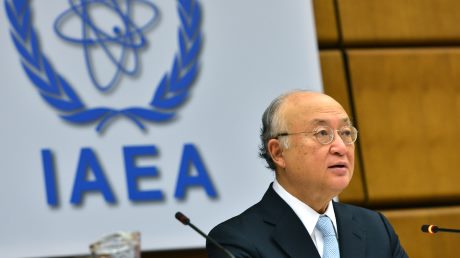International Atomic Energy Agency (IAEA) director general Yukiya Amano highlighted a major report on the Fukushima nuclear accident and agreements paving the way for a low-enriched uranium (LEU) 'fuel bank' in his introductory statement to the IAEA's Board of Governors yesterday.
 |
| IAEA director general Yukiya Amano makes his opening statement to the Board of Governors (Image: D Calma/IAEA) |
The IAEA's 35-strong board generally meets five times per year to examine and make recommendations to the agency's General Conference, held every September, on the IAEA's accounts, program and budget. It also considers applications for membership.
Amano described the Fukushima report as "an authoritative, factual and balanced assessment of what happened at Fukushima Daiichi". The result of an extensive international effort involving some 180 experts from 42 IAEA member states and other organizations over two years, it draws on five detailed technical volumes which will be issued before the General Conference. It also aims to be accessible for a non-technical audience, he said.
"There can be no grounds for complacency about nuclear safety in any country. Some of the factors that contributed to the Fukushima Daiichi accident were not unique to Japan," Amano noted, adding that continuous questioning and openness to learning from experience are key to safety culture and are essential for everyone involved in nuclear power. "Safety must always come first," he said.
The report was delivered to the IAEA's member states in May, but must be considered by the Board of Governors prior to its public release which is scheduled to take place during the IAEA General Conference in September.
Banking on agreement
Board approval is also being sought for two key agreements underpinning the establishment of the IAEA LEU 'fuel bank' in Kazakhstan: a host state agreement between the IAEA and Kazakhstan on the establishment of the reserve in that country; and a draft transit agreement between the IAEA and Russia to permit the IAEA to transport LEU through Russia to and from the 'bank'.
The facility would provide a reserve of fuel to be made available to IAEA member states, at market prices, as a last resort should they find themselves unable to obtain LEU for power generation on the global commercial market. The IAEA has been working since 2010 to establish the reserve, which aims to hold enough LEU to meet the fuel fabrication needs for two to three reloads of fuel for a 1000 MWe light water reactor.
Kazakhstan volunteered to host the repository in 2010, and the country's energy minister signed the draft agreement with the IAEA on 27 April. The facility looks likely to be sited at the Ulba Metallurgical Plant at Ust-Kamenogorsk in eastern Kazakhstan.
Amano described the conclusion of the two agreements as a "significant milestone" for the project, enabling the IAEA to proceed to full-scale implementation. Two related technical agreements are also near to finalization, and are expected to be signed at the same time as the host state agreement, he added.
Researched and written
by World Nuclear News







_53514_33880.jpg)






